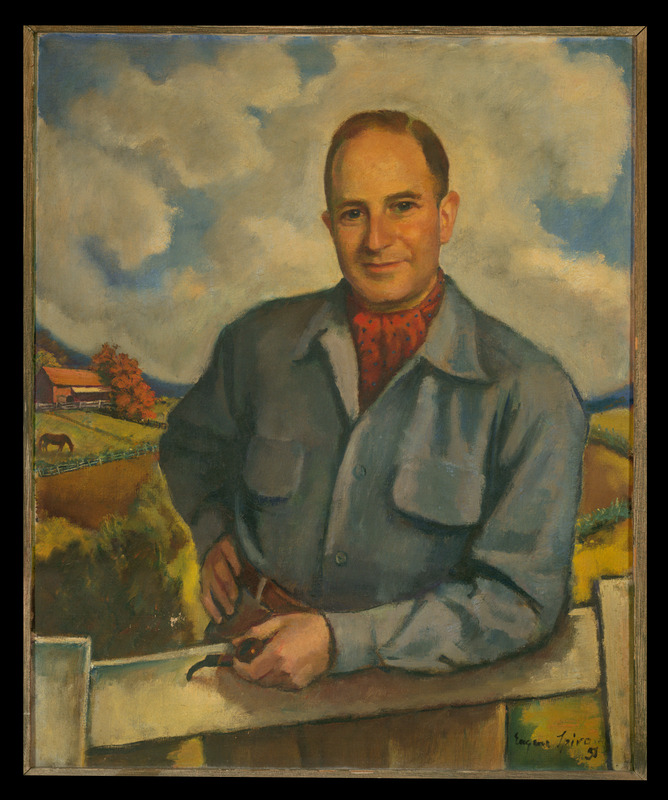Biographical/Historical Information
Max Georg Lowenherz (May 28, 1909 – September 13, 2003) was born in Coburg, Germany to a Jewish family. His father was David Löwenherz, a businessman, and his mother was Clara Löwenherz (nee Backhaus). In 1933, Max fled Germany, shortly after being arrested during mass incarcerations of Jews in Coburg. Max joined his brother Heinz in Amsterdam, where Heinz had set up a photo agency called “Photo Mundi”. Another brother, Walter, left for Paris to set up a photo agency called “Agence Claire,” named in honor of their mother Clara. Max was able to migrate to New York in 1937, later joined by Walter. Max founded a new photo agency in New York which came to be called "Three Lions, Inc, after the three brothers and in homage to their last name (which means "lion-heart" in German). Heinz and his family were later transported to Westerbork in Holland, and eventually killed in Auschwitz.
Three Lions, Inc. was a successful picture agency that licensed works by international photographers, sometimes photos of celebrities and other notable people, and picture stories used in national and international magazines. Of particular note, Three Lions, Inc. commissioned a series of photographs by Orlando Suero in 1954 of Senator John and Jacqueline Kennedy at their home in Georgetown, Virginia. In 1938, Max married Eva Cohnreich, a young photographer who had briefly worked with the Three Lions, Inc., and herself a recent German Jewish émigré to New York. Eva and Max had three children: their oldest daughter, Claire (later Claire Brunner), was born in 1939. Margaret (Peggy, later Margaret Stolowitz) was born in 1942, and their son David was born in 1951. Eva and Max later divorced around 1965. His oldest friend from Coburg was the political scientist, Hans Morgenthau. Three Lions, Inc was sold in 1983, and in 1989, Lowenherz donated the agency's archive of Kennedy photographs and negatives, most taken in 1954, to Johns Hopkins University. He died in 2003.
Eugene Spiro, born Eugen Spiro (1874– 1972) was a German and American painter. He was born to a Jewish family in Breslau, Germany (Wroclaw, Poland), the son of a synagogue cantor. He studied art in Breslau (under Albrecht Bräuer), Munich (under Franz von Stuck), and in Italy. In 1904 Spiro was briefly married to the famous actress Tilla Durieux, who later married the important art dealer Paul Cassirer. His younger sister was the painter Baladine Klossowska. The French painter Balthus was his nephew. After an extended stay in Berlin from 1906 to 1914, Spiro settled in Paris, where he belonged to a group of artists that met at the Café du Dôme. He received a professorship at the Académie Moderne, was elected to the Académie Des Beaux-Arts and co-founded the Salon d'Automne. The outbreak of WW I forced him to return to Germany, where he soon became a popular portrait painter. From 1915 to 1933 Spiro was on the executive board of the Berlin Secession and a professor at the Staatliche Kunstschule. The Nazi takeover forced Spiro into emigration. The sixty-one-year old went to Paris in 1935, where he founded the Union Des Artistes Libres in 1936. During this time, he met his wife Lily Jacoby at a French internment camp in Gurs. After the German occupation of France in 1940, Spiro and his wife emigrated to America, settling in New York in 1941. Spiro worked as a teacher at the Wayman Adams School in Elizabethtown, New York and at Dartmouth College. He participated in exhibits in the United States for the rest of his life. Eugen Spiro died in New York in 1972.
Reproductions and Permissions
We welcome fair use of this content. Please credit the Leo Baeck Institute in your citation. For usage policies and to request higher resolution images, see Reproductions and Permissions.
Citation
Spiro, Eugen: [Portrait of Max G. Lowenherz], Leo Baeck Institute, 2017.21.
